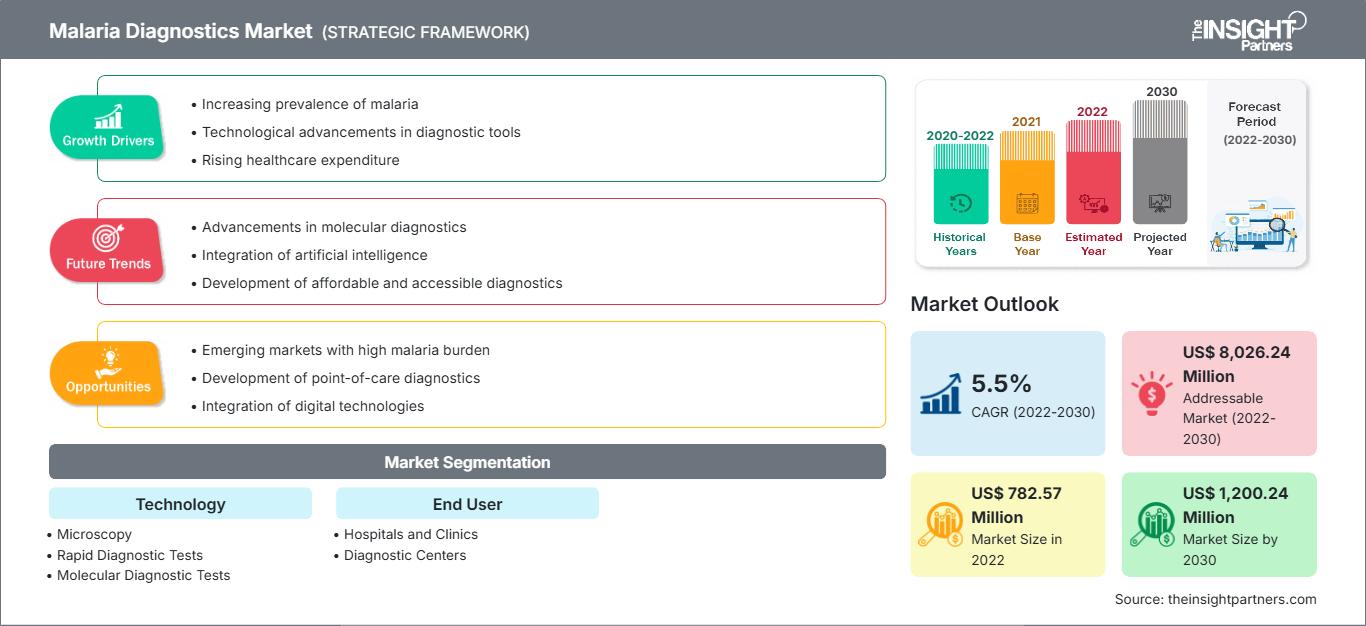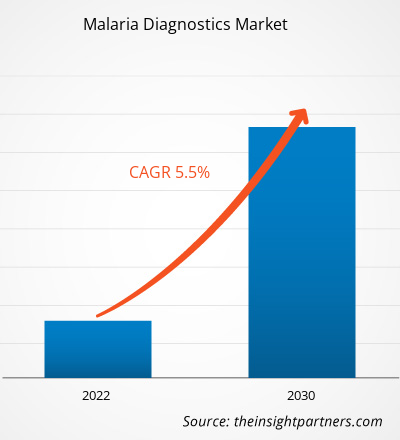[Forschungsbericht] Der Markt für Malariadiagnostik soll von 782,57 Millionen US-Dollar im Jahr 2022 auf 1.200,24 Millionen US-Dollar im Jahr 2030 wachsen; der Markt wird zwischen 2022 und 2030 voraussichtlich eine durchschnittliche jährliche Wachstumsrate (CAGR) von 5,5 % verzeichnen.
Markteinblicke und Analystenmeinung :
Malaria ist eine lebensbedrohliche Krankheit, die durch den Parasiten Plasmodium verursacht wird. Der Markt für Malariadiagnostik wächst aufgrund der hohen Malaria-Inzidenz in Ländern mit niedrigem Einkommen und der weltweit von internationalen und nationalen Organisationen umgesetzten Malaria-Eliminierungsprogramme. Die zunehmende Einführung fortschrittlicher Diagnoseinstrumente und die zunehmende Forschungsaktivität für wirksame Therapeutika tragen zusätzlich zum Wachstum des Marktes bei.
Vor der COVID-19-Pandemie machte fast ein Drittel der endemischen Länder Fortschritte bei der Erreichung internationaler Ziele. Viele Länder mit geringer Malaria-Inzidenz waren Teil der WHO-Initiative „Elimination 2025“, einer Gruppe von 25 Ländern, die die potenzielle Eliminierung von Malaria bis 2025 anstreben. In etwa einem Drittel der Länder stagnierten die Fortschritte jedoch, während in den anderen Ländern die Malaria-Inzidenz anstieg. Länder mit einer größeren Krankheitslast neigen eher dazu, Daten diagnostischer Tests zu verwenden, um geografisch geeignete Interventionen zu stratifizieren und zu fokussieren, ungeachtet der anhaltenden Bedeutung von Tests und Screenings bei Ausrottungsversuchen.
Die Zahl der Malariafälle und -todesfälle stieg im ersten Jahr der COVID-19-Epidemie aufgrund geringfügiger Störungen im Fallmanagement und bei den Präventionsbemühungen. Dennoch konnte ein mögliches Worst-Case-Szenario – die Verdoppelung der Malaria-Todesfälle – durch die gemeinsamen Anstrengungen der WHO, der Nationalen Malariaprogramme und ihrer Partner vermieden werden. Schwierigkeiten bei der Beschaffung der notwendigen Malariavorräte und die Ungewissheit darüber, wie sich die Pandemie letztlich auf die Maßnahmen zur Malariabekämpfung auswirkte.
Wachstumstreiber:
Malaria, eine der akuten fieberhaften Erkrankungen, wird durch Plasmodium-Parasiten verursacht und durch infizierte weibliche Anopheles-Mücken verbreitet. Fünf Parasitenarten verursachen beim Menschen hauptsächlich Malaria, und zwei dieser Arten – Plasmodium falciparum und P. vivax – gelten als die größte Bedrohung. P. falciparum ist zudem der tödlichste Malariaparasit und auf dem afrikanischen Kontinent am weitesten verbreitet. Darüber hinaus ist P. vivax in den meisten Ländern außerhalb Afrikas südlich der Sahara der vorherrschende Malariaparasit. Laut dem Welt-Malaria-Bericht (WMR) 2020 der Weltgesundheitsorganisation (WHO) wurden weltweit 241 Millionen Malariafälle gemeldet, verglichen mit 227 Millionen Fällen im Jahr 2019. Der gleichen Quelle zufolge steigt die Zahl der durch Malaria verursachten Todesfälle jährlich um 69.000. Ungefähr zwei Drittel dieser Todesfälle, d. h. 47.000, wurden durch Störungen der Gesundheitsversorgung während der COVID-19-Pandemie verursacht; das verbleibende Drittel der Todesfälle, d. h. 22.000, spiegelt eine kürzlich geänderte Methodik der WHO zur Berechnung der Malaria-Mortalität wider (unabhängig von Störungen durch COVID-19).
Im Jahr 2020 wurden ca. 95 % der weltweiten Fälle und ca. 96 % der durch Malaria verursachten Todesfälle in der afrikanischen Region der WHO gemeldet, und ca. 80 % aller gemeldeten Todesfälle betrafen Kinder im Alter von 5 Jahren und darunter. Laut WMR 2021 wurden etwa 2 % der weltweiten Malariabelastung in südostasiatischen Ländern verzeichnet, wobei Indien im Jahr 2020 83 % der geschätzten Malariafälle und 82 % der mit der Krankheit verbundenen Todesfälle auf sich zog. Die steigende Malariaprävalenz in verschiedenen Regionen weltweit fördert somit das Wachstum des Marktes für Malariadiagnostik.
Auf dem Markt ist nur eine begrenzte Anzahl von WHO-präqualifizierten Produkten erhältlich, die keine PF-mRDTs sind. Trotz der Verfügbarkeit einer breiten Palette von WHO-präqualifizierten mRDT-Produkten konzentriert sich die Nachfrage auf eine bevorzugte Untergruppe spezifischer Produkte und Hersteller. Dies schränkt die Fähigkeit des Marktes ein, Angebotsvielfalt, -sicherheit und -produktionskapazität zu gewährleisten. Dementsprechend stehen die Hersteller vor Herausforderungen wie der geringen Produktnachfrage aus einigen Ländern sowie deren Zurückhaltung und mangelndem Interesse an der Einführung alternativer Produkte. Die Einführung alternativer Marken kann durch Änderungen der für die nationalen Algorithmen ausgewählten Marken oder durch Kostenauswirkungen ausgelöst werden.
Passen Sie diesen Bericht Ihren Anforderungen an
Sie erhalten kostenlos Anpassungen an jedem Bericht, einschließlich Teilen dieses Berichts oder einer Analyse auf Länderebene, eines Excel-Datenpakets sowie tolle Angebote und Rabatte für Start-ups und Universitäten.
Markt für Malariadiagnostik: Strategische Einblicke

-
Holen Sie sich die wichtigsten Markttrends aus diesem Bericht.Dieses KOSTENLOSE Beispiel umfasst Datenanalysen, die von Markttrends bis hin zu Schätzungen und Prognosen reichen.
Berichtssegmentierung und -umfang:
Der Markt für Malariadiagnostik ist nach Technologie und Endnutzer segmentiert. Der Markt für Malariadiagnostik ist nach Technologie in Mikroskopie, Schnelldiagnosetests (RDTs) und molekulardiagnostische Tests unterteilt. Das Segment der Schnelldiagnosetests (RDTs) hatte 2022 den größten Marktanteil und wird voraussichtlich zwischen 2022 und 2030 die höchste durchschnittliche jährliche Wachstumsrate (CAGR) im Markt verzeichnen. Der Markt für Malariadiagnostik ist nach Endnutzer in Krankenhäuser und Kliniken, Diagnosezentren und andere unterteilt. Das Segment Krankenhäuser und Kliniken hatte 2022 den größten Marktanteil. Das Segment Diagnosezentren wird voraussichtlich zwischen 2022 und 2030 die höchste CAGR auf dem Markt verzeichnen.
Segmentanalyse:
Der Markt für Malariadiagnostik ist nach Technologie in Mikroskopie, Schnelltests (RDTs) und molekulardiagnostische Tests segmentiert.
Das Segment Schnelltests (RDTs) hatte 2022 den größten Marktanteil und wird voraussichtlich zwischen 2022 und 2030 die höchste CAGR auf dem Markt verzeichnen. Durch den Nachweis von Malariaparasiten im menschlichen Blut unterstützen Malaria-Schnelltests (RDTs) die Diagnose von Malaria. RDTs bieten eine Alternative zur klinisch basierten Diagnose oder Mikroskopie, insbesondere in Situationen, in denen der Zugang zu hochwertigen Mikroskopiediensten eingeschränkt ist. Plasmodium falciparum oder P. vivax ist die einzige Art, die bestimmte RDTs identifizieren können, andere können jedoch vier Arten identifizieren: P. falciparum, P. vivax, P. malariae und P. ovale. Normalerweise wird zur Blutentnahme für den Test ein Fingerstich verwendet.
Der Markt für Malariadiagnostik ist nach Endverbrauchern in Krankenhäuser und Kliniken, Diagnosezentren und andere unterteilt. Krankenhäuser und Kliniken entwickeln sich mit der steigenden Zahl von Patienten weltweit deutlich weiter. Sie bieten hochwirksame Behandlungen in kostengünstigen Umgebungen. Die zunehmende Bedeutung von RDTs aufgrund ihrer schnellen Durchlaufzeiten, niedrigen Kosten und bequemen Zugänglichkeit ist einer der Hauptgründe für die Dominanz von Kliniken auf dem Markt für Malariadiagnostik.
Regionale Analyse:
Der globale Markt für Malariadiagnostik ist geografisch in Nordamerika, Europa, Asien-Pazifik, Süd- und Mittelamerika sowie den Nahen Osten und Afrika unterteilt. Aufgrund steigender Investitionen von Industrienationen wie den USA, größerer Patientenpopulationen und der zunehmenden Betonung der Weltgesundheitsorganisation (WHO) auf der Senkung der Malaria-Sterblichkeitsrate in afrikanischen Ländern wird erwartet, dass die Region Naher Osten und Afrika ihre Marktdominanz im Prognosezeitraum beibehalten wird. Basierend auf Daten, die die WHO im Juli 2022 veröffentlichte, ist es wahrscheinlich, dass etwa 95 % der Krankheitsfälle und 96 % der Todesfälle auf Subsahara-Afrika entfallen.
Markt für Malariadiagnostik
Markt für MalariadiagnostikDie Analysten von The Insight Partners haben die regionalen Trends und Faktoren, die den Markt für Malariadiagnostik im Prognosezeitraum beeinflussen, ausführlich erläutert. In diesem Abschnitt werden auch die Marktsegmente und die geografische Lage in Nordamerika, Europa, dem asiatisch-pazifischen Raum, dem Nahen Osten und Afrika sowie Süd- und Mittelamerika erörtert.Umfang des Marktberichts zur Malariadiagnostik
| Berichtsattribut | Einzelheiten |
|---|---|
| Marktgröße in 2022 | US$ 782.57 Million |
| Marktgröße nach 2030 | US$ 1,200.24 Million |
| Globale CAGR (2022 - 2030) | 5.5% |
| Historische Daten | 2020-2022 |
| Prognosezeitraum | 2022-2030 |
| Abgedeckte Segmente |
By Technologie
|
| Abgedeckte Regionen und Länder |
Nordamerika
|
| Marktführer und wichtige Unternehmensprofile |
|
Dichte der Marktteilnehmer im Bereich Malariadiagnostik: Auswirkungen auf die Geschäftsdynamik verstehen
Der Markt für Malariadiagnostik wächst rasant. Die steigende Nachfrage der Endverbraucher ist auf Faktoren wie veränderte Verbraucherpräferenzen, technologische Fortschritte und ein stärkeres Bewusstsein für die Produktvorteile zurückzuführen. Mit der steigenden Nachfrage erweitern Unternehmen ihr Angebot, entwickeln Innovationen, um den Bedürfnissen der Verbraucher gerecht zu werden, und nutzen neue Trends, was das Marktwachstum weiter ankurbelt.

- Holen Sie sich die Markt für Malariadiagnostik Übersicht der wichtigsten Akteure
Branchenentwicklungen und Zukunftschancen:
Nachfolgend sind verschiedene strategische Entwicklungen führender Akteure auf dem Markt für Malariadiagnostik aufgeführt:
- Im Februar 2022 brachte das Kenya Medical Research Institute (KEMRI) Plasmochek für Malariatests auf den Markt. Plasmochek dient dem Nachweis von Plasmodium, einem Parasiten, der Malaria verursacht. Das Kit verwendet Antikörper, die spezifisch gegen Plasmodium falciparum Histidin-reiches Protein II und Plasmodium-Lactatdehydrogenase gerichtet sind, um Malariainfektionen nachzuweisen.
- Im Dezember 2019 entwickelten Access Bio und Global Good (ein Kooperationspartner von Access Bio) einen neuen ultrasensitiven Schnelltest (uRDT), der beim Nachweis von Histidin-reichen Protein-2-Antigenen (HRP2) fünfmal sensitiver ist als derzeit verfügbare uRDTs. Darüber hinaus wurden verschiedene Tools zur Verbesserung der Malariadiagnose entwickelt.
Wettbewerbslandschaft und wichtige Unternehmen:
Access Bio., Inc.; Abbott Laboratories; Premier Medical Corporation Pvt. Ltd.; Sysmex Partec GmbH; bioMerieux; Beckman Coulter Inc.; Siemens Healthineers; Leica Microsystems GmbH; Nikon Corporation; Olympus Corporation; und Bio-Rad Laboratories Inc. sind die führenden Unternehmen auf dem Markt für Malariadiagnostik. Diese Unternehmen konzentrieren sich auf neue Technologien, die Verbesserung bestehender Produkte und geografische Expansionen, um der weltweit wachsenden Verbrauchernachfrage gerecht zu werden.
- Historische Analyse (2 Jahre), Basisjahr, Prognose (7 Jahre) mit CAGR
- PEST- und SWOT-Analyse
- Marktgröße Wert/Volumen – Global, Regional, Land
- Branchen- und Wettbewerbslandschaft
- Excel-Datensatz
Aktuelle Berichte
Erfahrungsberichte
Grund zum Kauf
- Fundierte Entscheidungsfindung
- Marktdynamik verstehen
- Wettbewerbsanalyse
- Kundeneinblicke
- Marktprognosen
- Risikominimierung
- Strategische Planung
- Investitionsbegründung
- Identifizierung neuer Märkte
- Verbesserung von Marketingstrategien
- Steigerung der Betriebseffizienz
- Anpassung an regulatorische Trends






















 Kostenlose Probe anfordern für - Markt für Malariadiagnostik
Kostenlose Probe anfordern für - Markt für Malariadiagnostik